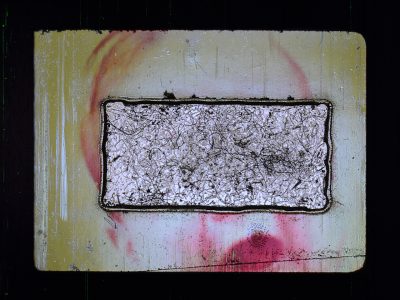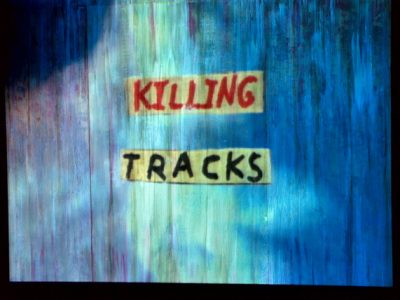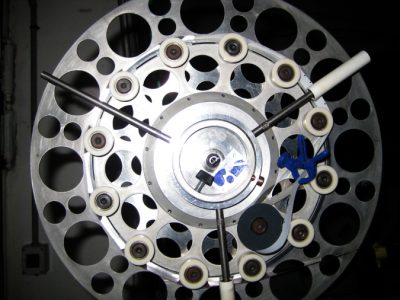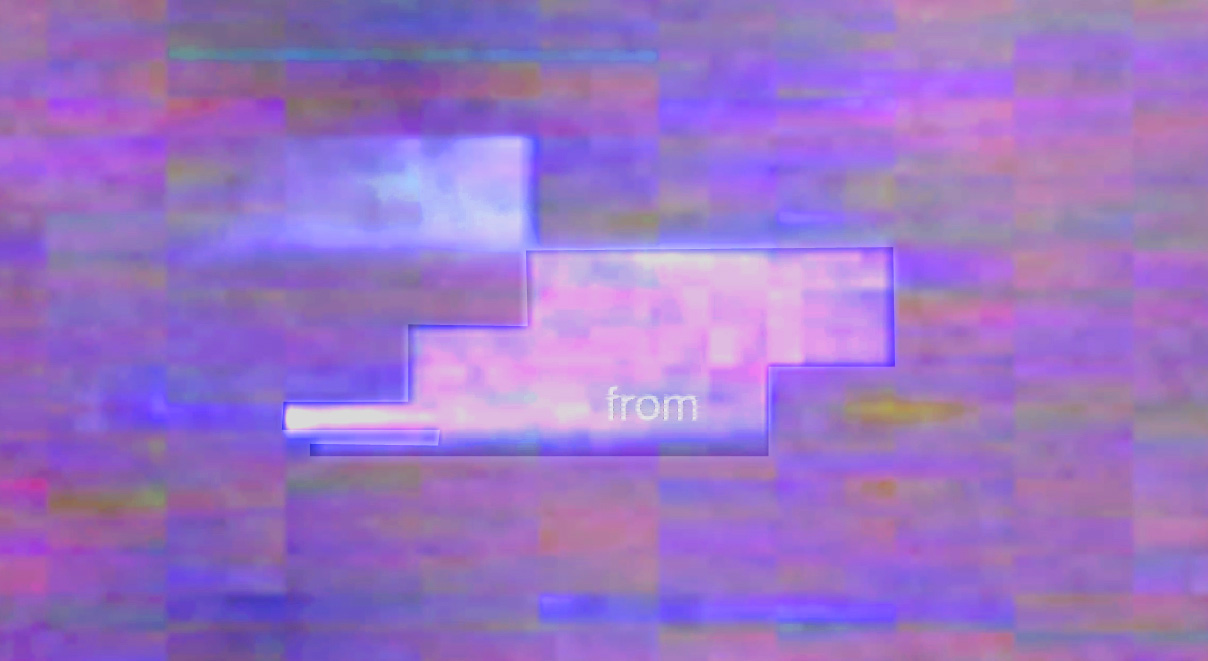
The screen, the body, poetry, and the document: an overview my practice in relation to the 16th Street Theater
Process/Research ,
(Posted 6/06/10 with a few image updates 1/2019)
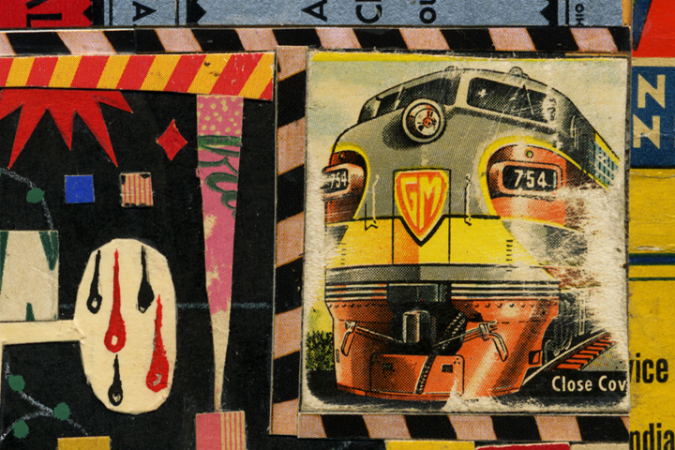
This Train will be my third collaboration with Chicago’s 16th Street Theater and director Ann Filmer. In 2008 The Scarlet Ibis by poet Susan Hahn, in 2009 Fires in the Mirror by author and performer Anna Deavere Smith, and now This Train by artist, poet, and performer Tony Fitzpatrick. Though three very different pieces, they all blur the lines between poetry, documentary, and portraiture, as well as traditional forms of theater, performance, and social critique. I have and will continue to explore these themes in my solo practice. Formally these theatrical collaborations further my understanding and use of the virtual pictorial space: screen, container, image window, in relation to real physical bodies and objects, and the use of text and image textualities.
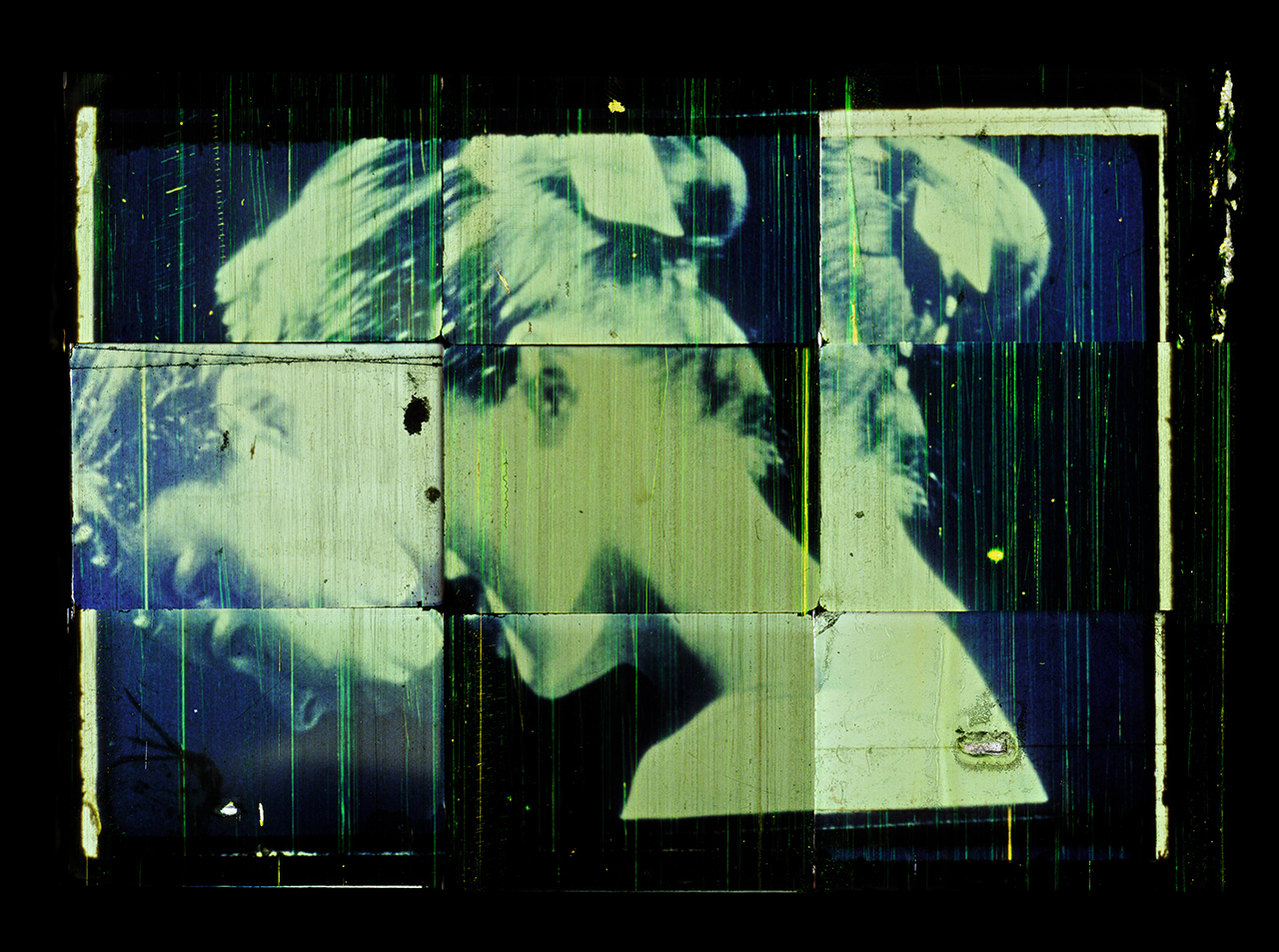
The individual productions and my solo bodies of work are separated by their narrative trajectory, but each help to solve problems, answer questions, and open doors to new influences that informs the work in my practice overall. The various bodies of work I’m discussing have overlapping formal and conceptual threads. I get excited discovering the common ground I share with the text and my collaborators, which is sometimes embedded deep in their practice history. This common ground also acts as reinforcement that I’m on the right track with my work’s overall trajectory. My work frequently starts as a gut reaction or desire to create an experience or record of something that I want others to experience as a means to really understand, feel, and see it. I believe the work can also act as a voice to those whom might not otherwise be heard or seen. This relates to the 16th Street Theater works as well as my resent project, The Devil’s in the Details.
Karaoke for Prosperity: Video Haiku

Filmer considered me for the video design position for The Scarlet Ibis after my solo show at The 16th Street Theater, Karaoke for Prosperity: Video Haiku. The show consisted of two parts. The first part was a karaoke style performance using the song “Free Bird” as a form of social ritual. With a therapeutically humorous purpose of “setting free the broken hearted”, the audience was encouraged to sing along to the projected lyrics. During the epic guitar shredding solo, I read and paper-shredded the stories of the broken hearted. The piece consisted of myself performing in front of the projection of original experimental video inspired by the lyrics, heartbreak (both my own and that of other’s found on blogs and social networking sites), and my experience of waking up after a break-up with the lyrics of “Free Bird” looping in my head for three days and nights: pop therapy.
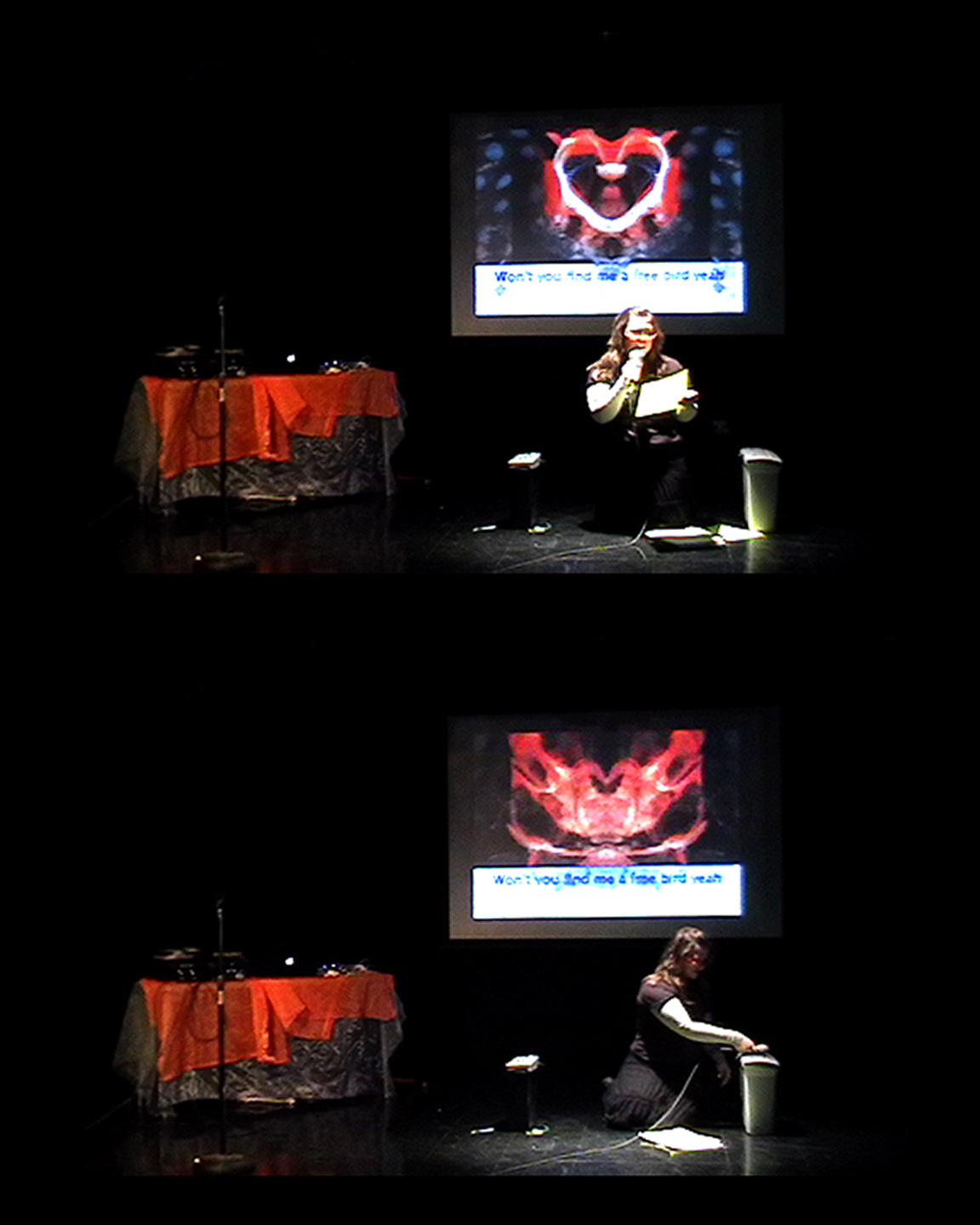
The second half of the show contained three single channel video haiku. The video haiku form was developed from the research of haiku expert Henry Blyth regarding the philosophy and history of the haiku: meaning is sensation expelled within one breath. This video was not created in response to an existing haiku or contained textual words, but a poem written with images and sound. I also thought of them as self-portraits, documenting a period of time in which I was experiencing both extreme lows and highs. I wanted to create and share the sensation of the conflicting inertia I felt being stuck at full velocity.
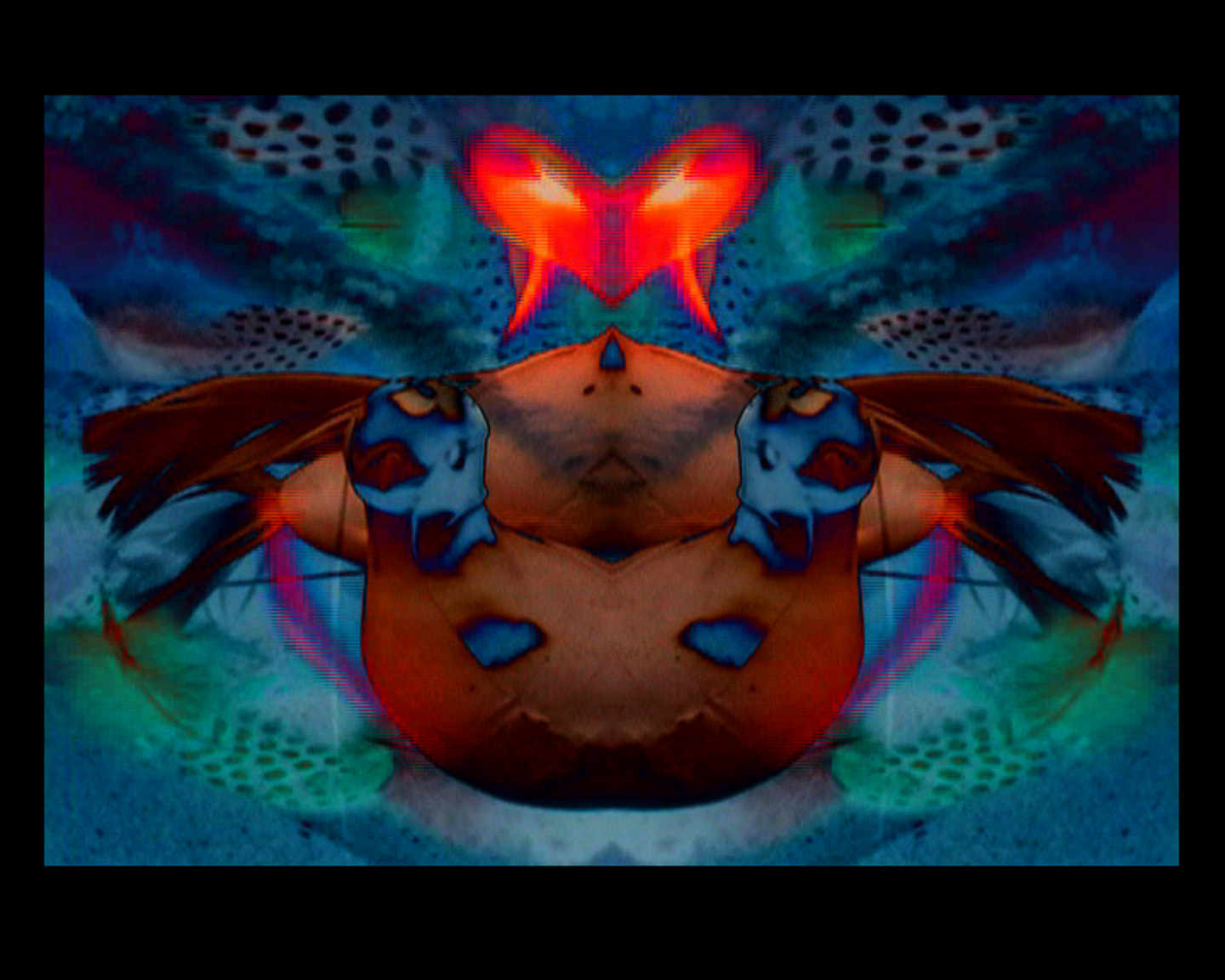
The three video haiku also contain the serendipitous moment I experienced when discovering I shared the same dream of Sylvia Plath’s fictional autobiographical character in her work Johnny Panic and the Bible of Dreams. I had produced a series of still images from this shared dream space and included some of them as the reoccurring middle verse that all three video haiku shared. I think that this is relevant because later while researching Hahn’s practice, I discovered that Plath had been an influence on Hahn and this work directly lead to my working with and discovering Hahn. Before seriously perusing poetry, Hahn had been a psychotherapist and used the process of writing and reading poetry as therapy for her patients. Plath was one of the poets she shared with her patients and Hahn’s work has been described as having similar qualities of Plath’s work. Even though this did not come into play with the production of The Scarlett Ibis directly, I feel it is important to look ahead while also look back at your influences and the influences of your influences. I think of this common ground between Hahn and myself in terms of space, similar to a virtual artifact or window that I’m framing my work in at this time.

A visit to Japan was an additional influence to the show overall. The title phrase “..for Prosperity “ came from various public English texts I read during my trip advising on the social rules and personal choices that would result in prosperity for all. I would also like to communicate a form of guidance to achieve prosperity for all. I had started working on the research for my video haiku before my trip and had conceived of the karaoke performance a few years earlier. It made since to include them into one show as both karaoke and haiku originated in Japan.
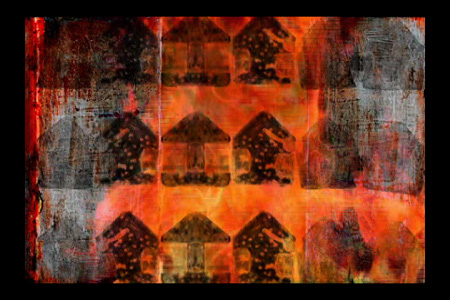
The Scarlet Ibis
Filmer recognized that my video haiku concept as visual poetry had possibilities for The Scarlet Ibis, as the play was a word for word staging of Hahn’s complete book of poetry under the same name. I had also complete a successful video design for the play Patty Red Pants in 2005 and had been working with the sound designer from that play, Barry Bennett, for several years as the image component to his experimental improvisational rock band, Milkbaby. For both of these projects I created original ephemeral landscapes that added both a conceptual and immersive layer to the performances. The video was not created to illustrate what was already present nor act as a lighting effect, but to contribute as an autonomous but balanced part of the whole.
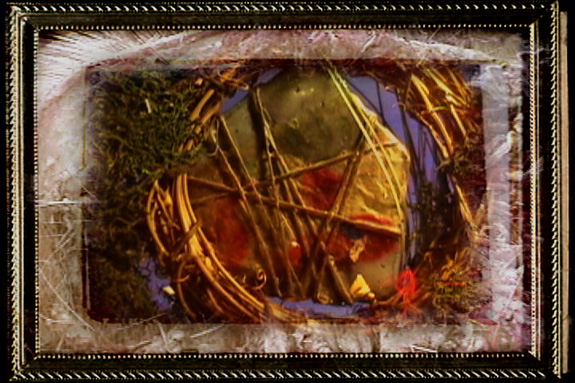
For The Scarlet Ibis, I created a virtual poetic landscape for each of the 34 poems and between the three acts, video haiku, using the same durational and conceptual structure I had created for my solo work. The landscapes consisted of fantastical imagery built from feathers, wax, moss, images that had inspired and informed Hahn’s writing, and documentation of actual places that where relevant to the poetic narrative such as the castles and gas chambers of Dachau, Germany. Each of the three acts had a different and specific conceptual point of view that Filmer directed me towards: act one the Bird so the nest was the frame/window, act two the Lady who was a magician’s assistant so the stage became the frame/window, and act three contained both characters point of view space. I used the frame/window of a picture frame for this act as it seemed to be about personal history, memorial, remembering the past, and reflecting on mortality and in general.
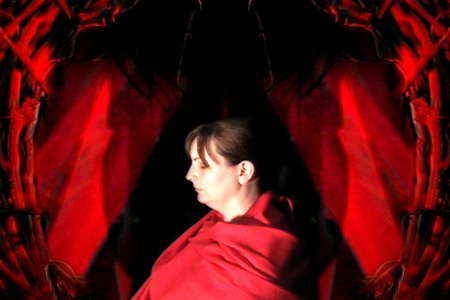
I also integrated the figure of the Lady, Hahn’s fictionalized self, embedded into some of the poem-scapes. The Lady character is the only figure that broke into this virtual space. It seemed appropriate because this character was Hahn’s fictionalized self and I liked the idea that she could exist in both of these planes simultaneously as she created them. Also, the scene where she first appears within the video is when her physical self is talking about her secret cancer that is taking over her mental space. This was the real life catalyst for this book of poetry while an image of a scarlet ibis became her muse. This obsession was the grounding place for the scene and the work. I believe by showing the Lady in simultaneous parallel planes it also reflects the real and fictional role of Hahn as poet and character, and perhaps this book of poetry as abstraction and document.
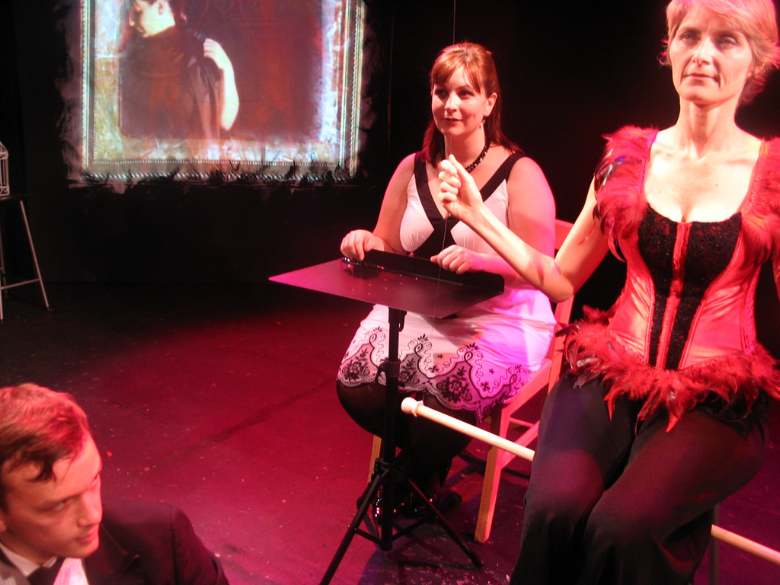
One of these behind the curtain poems videos had an uncanny resemblance to a dream I had prior to my first read of the script. My dream reveled that I was behind a curtain looking at myself in the mirror and discovered my hair had become a crown of ibis feathers. While I composed the background of the video out of physical objects and shot the Lady, actress Amy Dunlap, separately without knowing what form the final video would take, the composited image emerged unexpectedly as a my dream. This shared serendipitous image became the catalyst for my solo work involving myself in role of the scarlet ibis but within my own narrative history as a pediatric research subject. The ibis had been an exotic and rare hunted creature in both real history and in the context of Hahn’s book, which had been what I identified while in the real role of pediatric research subject.
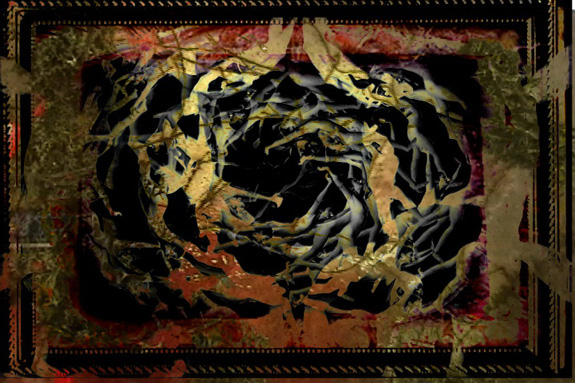
When starting this work I began by re-creating the duality between the front and back of the curtain, thinking of the examination in relation to a surreal performance. I quickly changed this work’s direction when I discovered that the landscape of pediatric research had changed from that of my youth with the FDA’s Modernization Act of 1997. As the restrictions where lifted for testing and pharmaceutical corporations where granted financial incentives, the amount of pediatric research subjects increased by 30,000 in one year. The metaphor of the exotic became the mass produced and my role and costume as an exploited exotic creature changed to an aggressive football tackler and researcher. I became empowered by a need to act and create a document so others could see and understand the complications to the patient doctor interface and inhumane consequences of this act.

Experimental Documentary and Fires in the Mirror

This change made me reconsider my practice from fictionalized autobiographical to experimental documentary. I think that my current work could be considered in regard to some of Bill Nichols’ categories of documentary film “modes” found in his book, Introduction to Documentary (2001). First the poetic mode, a more abstract and lyrical method, a play on the expository mode, “voice-of -god” argument, and the performative mode, frequently autobiographical and reviles the subjective hand at work. I believe Anna Deavere Smith’s play Fires in the Mirror, which was my second collaboration with 16th Street, fits into the concept of the Performative mode of documentary while also containing poetic intent. Smith describes her process in regards to these poetic terms in the article “Creative Reality: Anna Deavere-Smith” by Marcia Stepanek for the website Women in Communications:
“I look for the poem that a person has” she told AWC-DC on recent afternoon, leaning forward in her chair, less an effort to make a point than to follow her thought toward her listener. “So when I am conducting an interview, I am waiting for the rest of a person’s language to move out of the way for this poem to come forward”
In Fires in the Mirror and Smith’s practice in general, she records conversations with various individuals and then performs what they say word for word, transforming into these people during the performative process. I think that this process is important not as a mere document of what the person says or how they say it because it could be contained in a media recording. Instead it is in both the context of the performative mode of documentation, making subjective what is another person’s point of view, and then compounding that by staging this in front of an audience so they see the poetic moment when someone becomes another self. This giving up of your own self for the other in a public or performative setting is similar to activism and protest.
The video designer for Fires in the Mirror was minimalistic in comparison to The Scarlet Ibis. It consisted of the name and title of the individuals being depicted and documentary photography of the Brooklyn Heights’ riots and landscape that were at the heart of the play. I choose to emulate the printed publication of Fires in the Mirror as close as possible so the focus stayed on the performances, dialogue, and Smith’s work while still giving the audience a historic frame of reference.
This Train
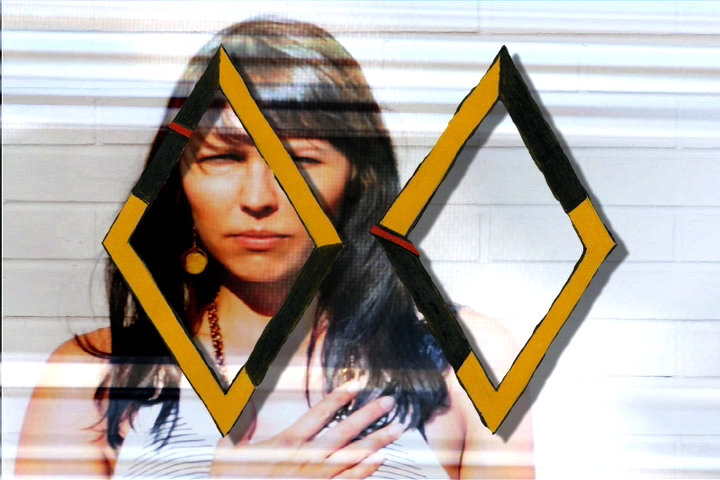
I see connective threads between Tony Fitzpatrick’s This Train and Fires in the Mirror, as both are associated with oral history, documentary and poetry. During his artist talk at Dieu Donne, Fitzpatrick descried his Hobo Alphabet collage series that This Train is inspired from as the writer Studs Terkel’s landscape and specifically sighted Terkel’s book Hard Times. Filmer described This Train to me as Fitzpatrick’s love letter to Studs. Studs traveled across the US interviewing hundreds of people for Hard Times creating an “oral history” of the Great Depression. This is in line with Smith’s interviewing process used for Fires in the Mirror. Tony has creating a Poetic mode of documentary inspired from an oral history mode with his 2D work and the play. He is giving a voice to the hobo by validating their language and raising them from faceless “trash” to a contributing population in the country that should not be ignored nor forgotten.
Fitzpatrick’s poetic and lyrical collage process extends into the 3D dimension with This Train allowing for a more expressive and poetic execution of the video design in comparison to Fires in the Mirror. The content of the design will rely heavily on the integration of Fitzpatrick’s 2D work, but after discussing with Filmer, I believe it will also contain photographic documentation of Chicago both past and present. I am also interested in documenting Fitzpatrick’s process of creating his 2D work, and visual cues to heighten the train concept and enhance the immersive effect of the play’s narrative arch. Ultimately this play is Fitzpatrick’s piece and even thought the theater is inherently a collaborative space and medium, he is the autonomous artist, performer, and writer. Until I work with him directly, it is hard to say what the design will become. I hope that my insights and research will be useful as well as applicable to his overall vision. I also hope that we discover shared common ground to cultivate the video. He did note that haiku was one of his influences during his talk at Dieu Donne. Perhaps that shared point of view will contribute to a mutual understanding.
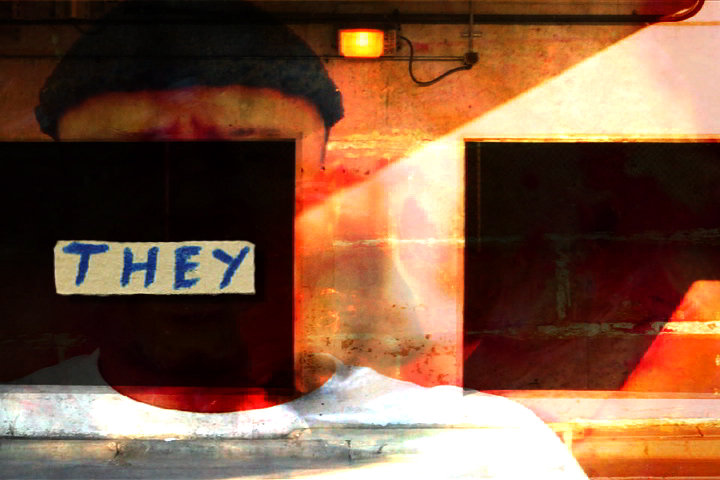
The one thing that I think the video can add is the dimension of time within the theatrical space, an idea credited to Robert Bloom in the text Digital Performance: A History of New Media in Theater, Dance, Performance Art, and Installation (2007). This time space can help in depicting the timeline of both physical and mental landscape in this country regarding the homeless though history. I also like the idea that this video space can suggest speed or the velocity of the “train” narrative. Before discussing my initial ideas with Filmer, I had been imagining the video space in This Train as a window to suggest the train window and the changing landscape. Filmer indicated that the play takes place in Fitzpatrick’s studio and in his real studio he has a window that looks out over Damen Ave and this could be the area of the video projection. I think that there is a possibility to integrate the train and studio window spaces into the design and was excited that my gut feeling has some practical application to the virtual staged architecture and Fitzpatrick’s real studio.
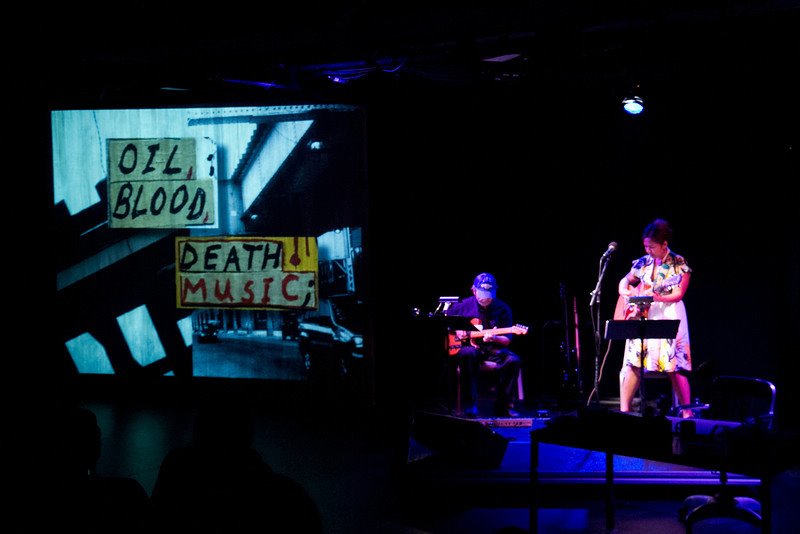
What is also exciting to me is the direct relationship of the window acting in the duel role as both a “real” physical space and a virtual metaphorical space. This has been an idea in relation to my solo practice as well as media theorist Anne Friedberg’s concept of the virtual window. I am very interested in processes that go back and forth between the real in terms of physical, historical, factual and the virtual in terms of ephemeral, digital, fantastical, and poetic.

The Devil’s in the Details and narrative

Before starting my series The Devil in the Details, which is when I started thinking about my work as more of an experimental documentary mode of expression, I categorized my process in terms of fictional autobiographical narrative and collage. I looked toward the structure of written language as a unifying thread of my multimedia approach: digital prints, single and multiple channel video, installation, and performance as well as integrated media such as video, film, found objects, encaustic, tar, text, and the figure all sharing pictorial space. This is how I broke down this language form comparison: a word or two in the form of a still image (later when researching the haiku format they became Japanese kanji: a conceptual container), a poem or a song would be the equivalent of a short video, and a novel or short story as a feature length video. I thought of editing time-based media as sentence or lyrical structure. The concept of collage came into play with the mixing of media and objects within 2D images, 3D space, and multiple screens acting as one piece.

I now think the unifying element in my practice is the virtual artifact and screen: pictorial plain, window, container; and the real physical objects, bodies (myself and others), and spaces that reside in relation to it; text and image textuality. This concept of virtual artifact and screen can reside as a print, monitor, projection, or web page. I create physical objects that exist within the screen and outside of it. I also think of my process as a whole as a transformative virtual space. For example I transformed the real Department of Human and Health Services logo into the Devils in the Details logo via my artistic enforcement over their symbolic body.

I animated this transformation with a digital process and brought it into the context of a physical space by cutting out the individual frames and making a paper wall, the logo stencils acting as “window” into a constructed 4’-wide by 4’-deep by 10’-tall room containing a video projection inside. Another example would be my point of view that the effect of the FDA’s Modernization Act of 1997, while a virtual thing, had a large physical affect over 30,000 children. In the process of moving them through this virtual space, they transformed from autonomous patients to mass produced names subjects. I have started to address this with my process both in and outside of the video space by producing both real cloth hospital gowns and representational paper gowns.
Digital Prints and the screen

Like a premonition of my theater collaborations to come, I had imagined my early 2D work as sketches for a kinetic pictorial plain or landscapes. I started applying significant black border to the works to speak to the notion of a container, a separation of space, or window as well as a sequence of cinematic events. Overtime I began to break this frame to suggest the element’s escape or to intensify its containment within this space. When showing this 2D work at Texas Tech University, it was described as ephemeral landscapes. I adopted this description as I had thought of them as an act of discovering, documenting, and understanding personal non-tangible moments like emotion, dreams, and remembering which are in the realm of the ephemeral. My work truly became ephemeral later when I started adapting and integrating it into the theatrical space as a projected element within the staged event. Not only did the work start to come alive with animated movement and time, but also I loved that they were contained within a durational arching event. In theater this event was narrative and with improvised multimedia music/dance/image performances there was always an emotional feel and climax to the show regardless as to its improvised structure. This is in contrast from a gallery setting which has no durational expectation or arch embedded into it.

Before working in the context of theater, I explored the notion of the layered pictorial window and duration container in my 70-minute narrative Monstriss. The story unfolds in Alice’s one room apartment with a television displaying the other characters in their separate space/channel. As the other individuals enter into her real life and therefore her personal and physical space, the television disappears. At times Alice places her hand on the screen to emphasize their physical and emotional separation. I was interested in spatial layering as the tension between the imagined and real. Later this tension between the screen space and “real” physical space was applied to my first the video design for the play Patty Red Pants.

Upon my reading of Lev Manovich’s The Language of New Media, I identified with his conclusion of Chapter 2 where he states, “..As was the case centuries ago, we are still looking at a flat, rectangular surface, existing in the space of our body and acting as a window into another space.” He draws comparison between two categories of screen: representational which has a distinct frame holding a mobile illusion; and simulation which blurs the boundary between the physical and conceptual space. I see my work using the screen as virtual container that exists in both a representation and simulated state. I’m interested in the reshuffling of these containers and the effect of this reshuffling between physiological and physical body.
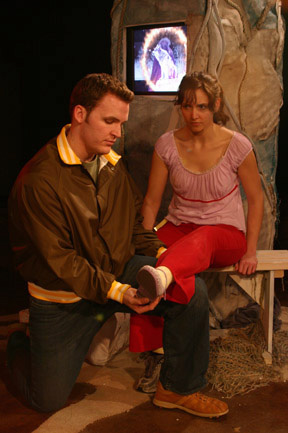
I was also recently introduced to Ann Friedberg’s concept of the virtual window at the Future of Digital Studies conference with the presentation of UF’s Maureen Turim’s paper “Metaphors and Devices in Anne Friedberg’s The Virtual Window”. The work spoke to the virtual and the architectural window, the fixed perspective of 2D and cinematic works and the multiple view of a digital platform. I’m excited to read this book to gain a much anticipated understanding of my work in relation to media and art theory overall. I had been searching for more of an understanding of how my work fits into a larger discourse for some time without feeling any significant connection with media and art theory until discovering this an Manovich’s work. I had instead been thinking in terms of haiku and visual music theory, which spoke to the notion of the “sensation” and ephemeral landscape.
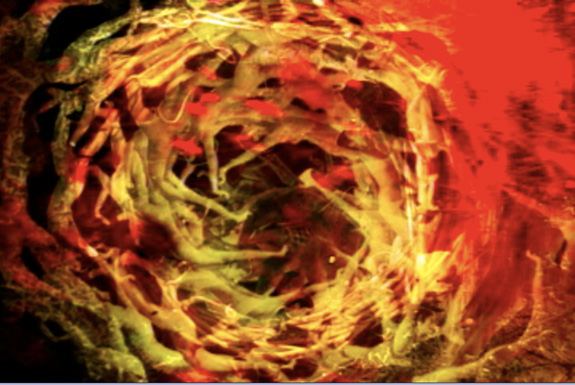
Next
Moving forward I need to devote myself to understanding the overall history and discourse of digital media in relation to theater and performance. One of the resources I plan to engage with is Steve Dixon’s Digital Performance: a history of new media in theater, dance, performance art, and installation. In addition to that and Anne Friedberg’s Virtual Window, I recent discovered Kate Mondloch’s Screens which talks about the screen in relation to both Manovich and Friedberg’s theories and the problematic and complicated relationship with narrative video in a gallery and installation space. Part of my motivation to work in a theater setting is that it allowed the time-based work to exist in a place where the audience is prepared for a fixed time commitment, unlike a gallery. My karaoke work was an idea on how I could place video art in an alternative gallery space, as people are use to seeing the combination of video and performance in a social karaoke context. I also want to gain technical understanding by engaging with the robust and user directed software MAX/MSP and JITTER to expand the possibilities of my work.
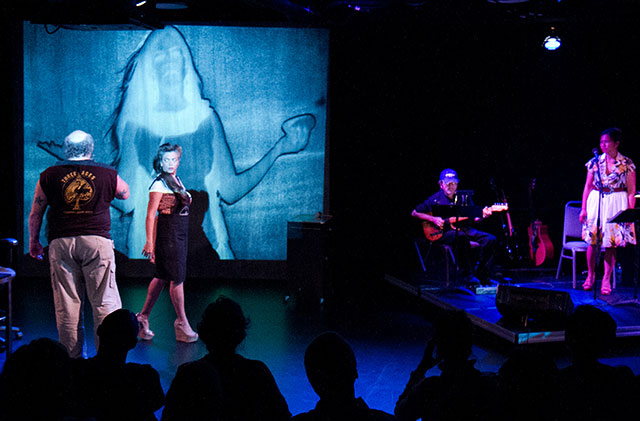
I am interested in theatrical projects that cross the line into the realm of high art. I hope that my experience with Fitzpatrick will help me understand how to successfully navigate between these different roles and institutionalized art spaces. I enjoy supporting art and theater that I see to be a form of activism even if my contribution is minimal, or my footprint unseen. I like to engage with the plays presented to me and find that poetic crack that I can explore and expand in a way that would not exist otherwise. Theater collaborations also allow me to really understand complex works that I admire. These reasons address my desire to create work in an act to understand and make visible to others that which I believe should be seen. As much as I would like to contribute to moving a medium or art forwarded, my overall priority is to contribute to the humanities to help move our society forward.
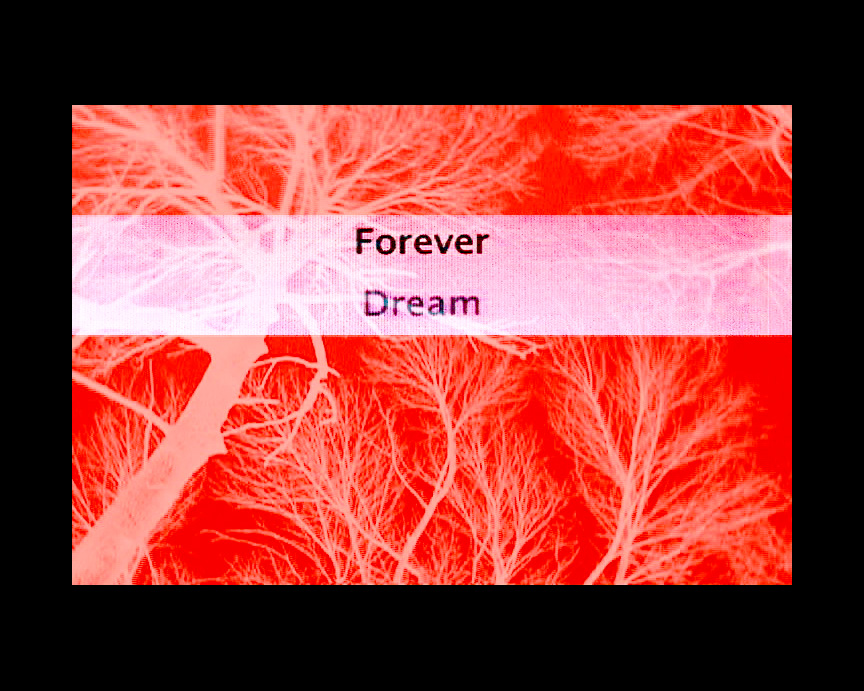
body, poetry, sensation.

